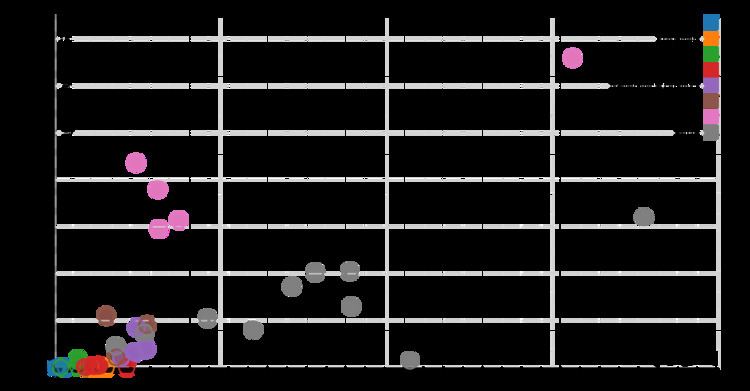 | ||
Material selection is a step in the process of designing any physical object. In the context of product design, the main goal of material selection is to minimize cost while meeting product performance goals. Systematic selection of the best material for a given application begins with properties and costs of candidate materials. For example, a thermal blanket must have poor thermal conductivity in order to minimize heat transfer for a given temperature difference.
Contents
- Ashby plots
- General method for using an Ashby chart
- Example of using an Ashby chart
- Performance index during tension
- Performance index during bending
- Selecting the best material overall
- Numerically understanding the chart
- References
Systematic selection for applications requiring multiple criteria is more complex. For example, a rod which should be stiff and light requires a material with high Young's modulus and low density. If the rod will be pulled in tension, the specific modulus, or modulus divided by density
Ashby plots
An Ashby plot, named for Michael Ashby of Cambridge University, is a scatter plot which displays two or more properties of many materials or classes of materials. These plots are useful to compare the ratio between different properties. For the example of the stiff/light part discussed above would have Young's modulus on one axis and density on the other axis, with one data point on the graph for each candidate material. On such a plot, it is easy to find not only the material with the highest stiffness, or that with the lowest density, but that with the best ratio
The first plot on the right shows density and Young's modulus, in a linear scale. The second plot shows the same materials attributes in a log-log scale. Materials families (polymers, foams, metals, etc.) are identified by colors.
Thus as energy prices have increased and technology has improved, automobiles have substituted increasing amounts of lightweight magnesium and aluminium alloys for steel, aircraft are substituting carbon fiber reinforced plastic and titanium alloys for aluminium, and satellites have long been made out of exotic composite materials.
Of course, cost per kg is not the only important factor in material selection. An important concept is 'cost per unit of function'. For example, if the key design objective was the stiffness of a plate of the material, as described in the introductory paragraph above, then the designer would need a material with the optimal combination of density, Young's modulus, and price. Optimizing complex combinations of technical and price properties is a hard process to achieve manually, so rational material selection software is an important tool.
General method for using an Ashby chart
Utilizing an "Ashby chart" is a common method for choosing the appropriate material. First, three different sets of variables are identified:
Next, an equation for the performance index is derived. This equation numerically quantifies how desirable the material will be for a specific situation. By convention, a higher performance index denotes a better material. Lastly, the performance index is plotted on the Ashby chart. Visual inspection reveals the most desirable material.
Example of using an Ashby chart
In this example, the material will be subject to both tension and bending. Therefore, the optimal material will perform well under both circumstances.
Performance index during tension
In the first situation the beam experiences two forces: the weight of gravity
The stress in the beam is measured as
Since both
Performance index during bending
Next, suppose that the material is also subjected to bending forces. The max tensile stress equation of bending is
Selecting the best material overall
At this point two performance indices that have been derived: for tension
For the tension performance equation
The bending performance equation
First, the best bending materials can be found by examining which regions are higher on the graph than the
Lastly, the
Numerically understanding the chart
The performance index can then be plotted on the Ashby chart by converting the equation to a log scale. This is done by taking the log of both sides, and plotting it similar to a line with
As seen from figure 3 the two lines intercept near the top of the graph at Technical ceramics and Composites. This will give a performance index of 120 for tensile loading and 15 for bending. When taking into consideration the cost of the engineering ceramics, especially because the intercept is around the Boron carbide, this would not be the optimal case. A better case with lower performance index but more cost effective solutions is around the Engineering Composites near CFRP.
